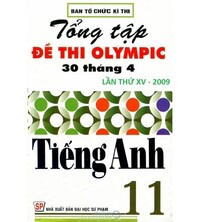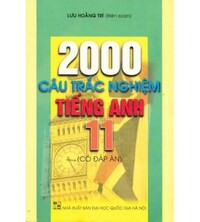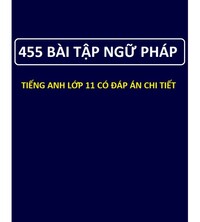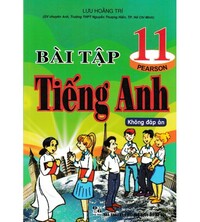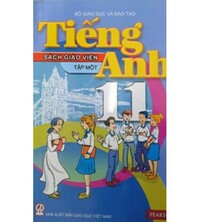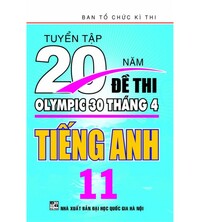Đề thi giữa kì 1 Tiếng Anh 11 Friends Global - Đề số 2
Find the word which has a different sound in the part underlined. Choose the word which has a different stress pattern from the others. Choose the best answer A, B, C or D to complete the sentences. Mark the letter A, B, C, or D to indicate the word(s) CLOSEST in meaning to the underlined word(s) in each of the following sentences. Mark the letter A, B, C, or D to indicate the word(s) OPPOSITE in meaning to the underlined word(s) in each of the following sentences.
Đề bài
I. PHONETICS
Find the word which has a different sound in the part underlined.
1. A. teenager B. privacy C. irritation D. hatred
2. A. adolescent B. independence C. distrust D. education
Choose the word which has a different stress pattern from the others.
3. A. figure B. drama C. ballet D. guitar
4. A. kayaking B. mountaineer C. instrument D. dialog
II. GRAMMAR AND VOCABULARY
Choose the best answer A, B, C or D to complete the sentences.
5. Helen _______ dolls for years and hers is a huge collection now.
A. has collected B. has been collecting
C. collected D. were collecting
6. Peter _______ as a bank manager for 30 years and retired at the age of 65.
A. worked B. had been working
C. had worked D. has worked
7. This is the fourth time we _______ Paris.
A. visited B. have been visiting
C. has visited D. had visited
8. I highly recommend this restaurant. The food is out of this _______.
A. earth B. world C. planet D. universe
9. Sitting in the front _______, I couldn’t enjoy the movie at all.
A. row B. desk C. line D. queue
10. You must see this new film. It _______ your favourite actor.
A. stars B. acts C. directs D. displays
11. We planned a ________ birthday party for him, but he wasn’t _______ at all.
A. surprised – surprising B. surprising – surprised
C. surprising – surprising D. surprised – surprised
12. With a mobile phone, an exchange student can easily stay in _______ with his family and friends in his home country.
A. communication B. touch C. correspondence D. contact
13. I don’t think young children _______ be allowed to use mobile phones at mealtime.
A. ought B. must C. better D. should
14. Much to our surprise, we _______ a huge sum of money from our uncle when he died.
A. left B. deposited C. mortgaged D. inherited
15. My cousin got married and quickly _______ down in Paris.
A. emigrated B. closed C. settled D. lived
Mark the letter A, B, C, or D to indicate the word(s) CLOSEST in meaning to the underlined word(s) in each of the following sentences.
16. I really admire Hellen Keller for all her efforts and determination.
A. doubt B. tolerate C. respect D. trust
17. Teenagers see the world differently and develop their own views.
A. arguments B. pictures C. sights D. opinions
Mark the letter A, B, C, or D to indicate the word(s) OPPOSITE in meaning to the underlined word(s) in each of the following sentences.
18. Home (2009) has been made available in different languages so that it will be of educational benefits to a larger audience.
A. unrestricted B. impractical C. unusable D. inaccessible
19. Natural disasters, such as storms, are the direct consequences of climate change.
A. causes B. impacts C. root D. development
Make the correct form of the verbs in the brackets.
20. I (come) ________ home late. I promise!
21. My parents (get) ________ married in 1999 and they (have) _______ 2 years after.
22. They (know) ______ each other since they (be) ______ young children.
Choose a/an/the to fill in the blanks.
23. My dad is _______ Math teacher. In fact, he is _______ only teacher in our family.
24. She is known as one of ______ most beautiful girls in this town.
25. You can earn about 100$ ______ hour by doing this job, but it also puts high demands on the data quality.
III. READING
Choose the word or phrase among A, B, C or D that best fits the blank space in the following passage.
The most important (26)_______ of a person’s life is the first few years when he/she is a child. It is in these years (27)_______ the brain grows the fastest. The brain makes more than one million new connections every second. In actual fact, it is widely held that 80 percent of the brain is formed by the time a child (28)_______ three. A child needs food, play and love to grow mentally and physically. Half of each meal a baby eats is used to (29)_______ his/her brain. All the energy from the meal is devoted to making the brain connections. A child learns a lot during his/her playtime and develops a sense of security in his/her parent’s love. (30)_______, as parents, one should never underestimate the power of nutritious food, playtime and food.
26. A. part B. phase C. era D. season
27. A. that B. when C. which D. where
28. A. develops B. becomes C. turns D. has
29. A. build B. built C. building D. have built
30. A. However B. Moreover C. Lastly D. Therefore
Read the text and choose the correct answers.
Sporting memorabilia has always been the craze among fans of all kinds of sports. Collecting sporting memorabilia is a fun and exciting way to show your love and passion for sports. The most common reason for collecting memorabilia is its sentimental value. Memorabilia bring back collectors’ special memories of their favourite teams, players, or sports moments. Some other people take great lengths in pursuing the rare items. They say that the thrill of the search is as rewarding as owning one and that is an adventure of excitement. Some others collect sports memorabilia as a form of investment. Many items get increasingly valuable over time. These are the ones associated with legendary players or historic moments. Ultimately, collecting sports memorabilia is a matter of personal choice depending on individual preferences and motivations. Whatever kind of collectors, it’s undeniable that collecting sporting memorabilia is a way to show our appreciation of the sports we love.
31. What does the passage mainly discuss?
A. The benefits of collecting memorabilia B. The ways to collect memorabilia
C. The causes of collecting memorabilia D. The guide to collect memorabilia
32. The word “craze” is closest in meaning to _______.
A. madness B. happiness C. trend D. aim
33. Which of the following is NOT true of collecting memorabilia?
A. Most people collect memorabilia for emotional reasons.
B. It is the best way to show you love a sport.
C. Memorabilia can be a form of investment.
D. Some people try hard to own rare memorabilia.
34. It can be inferred from the passage that _______.
A. memorabilia’s value stays unchanged throughout the years
B. owning one item of memorabilia is the most important
C. what memorabilia to collect reflects collectors’ likes and dislikes
D. memorabilia are collected only for fun and childhood memories
35. What is the tone of the passage?
A. Neutral B. Approving C. Disapproving D. Sarcastic
WRITING
Rewrite the following sentences, using the suggestions.
36. I have never been to such an impressive toy museum before.
This is _________________________________________.
37. I haven’t been to the cinema for two months.
The last _________________________________________.
38. I hang out with Elena a lot, but now we don’t often meet each other.
I used ___________________________________________.
39. I find getting up early difficult.
I’m _____________________________________________.
40. If I were you, I would try different kinds of food.
I think __________________________________________.
----- THE END -----
Đáp án
HƯỚNG DẪN GIẢI
Thực hiện: Ban chuyên môn
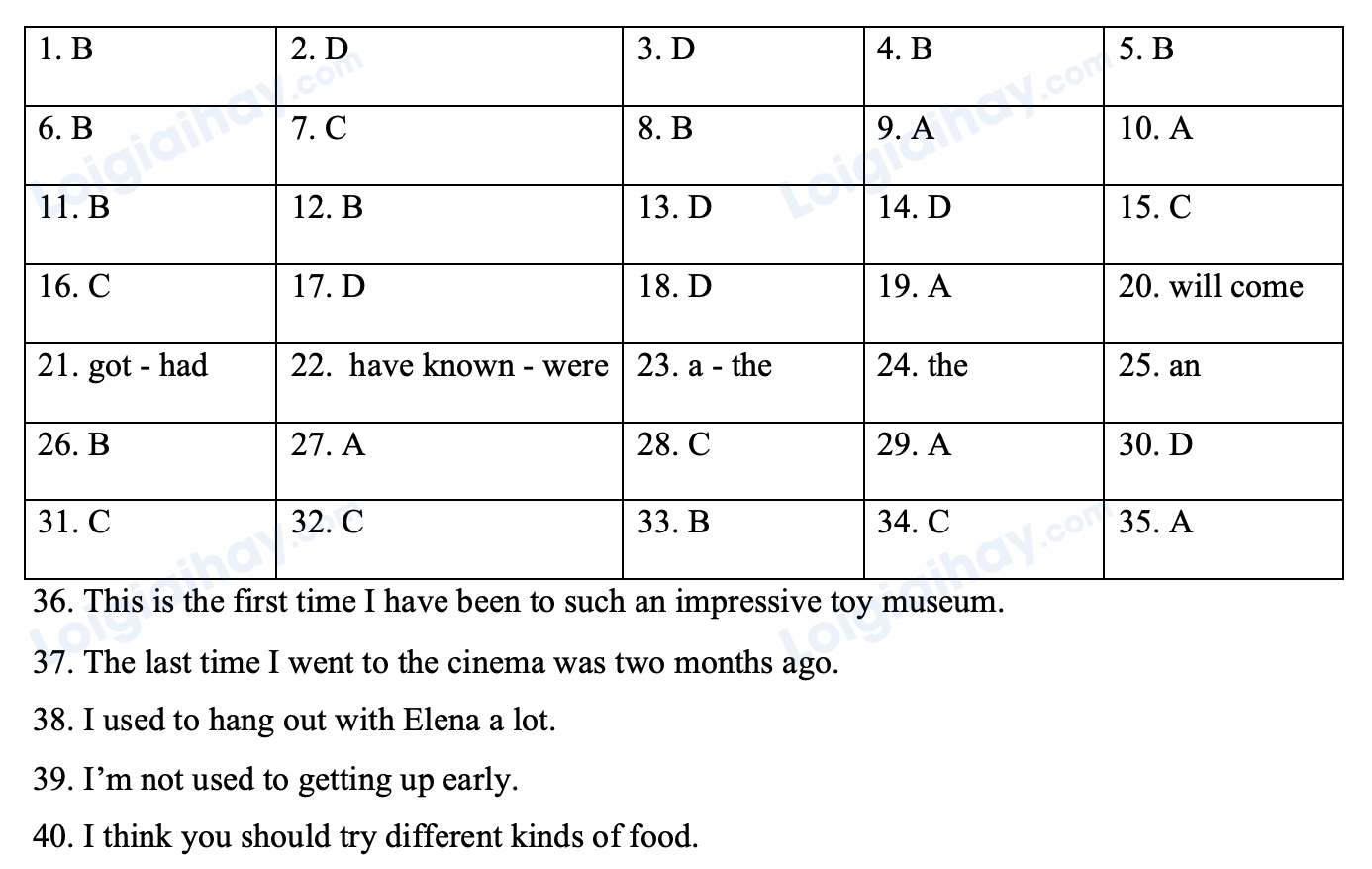
HƯỚNG DẪN GIẢI CHI TIẾT
1. B
Kiến thức: Phát âm “a”
Giải thích:
A. teenager /ˈtiːnˌeɪ.dʒər/
B. privacy /ˈprɪv.ə.si/
C. irritation /ˌɪr.ɪˈteɪ.ʃən/
D. hatred /ˈheɪ.trɪd/
Phần được gạch chân ở phương án B được phát âm /ə/, các phương án còn lại phát âm /eɪ/
Chọn B
2. D
Kiến thức: Phát âm “d”
Giải thích:
A. adolescent /ˌæd.əˈles.ənt/
B. independence /ˌɪn.dɪˈpen.dəns/
C. distrust /dɪˈstrʌst/
D. education /ˌedʒ.ʊˈkeɪ.ʃən/
Phần được gạch chân ở phương án D được phát âm /dʒ/, các phương án còn lại phát âm /d/
Chọn D
3. D
Kiến thức: Trọng âm
Giải thích:
A. figure /ˈfɪɡ.ər/
B. drama /ˈdrɑː.mə/
C. ballet /ˈbæl.eɪ/
D. guitar /ɡɪˈtɑːr/
Phương án D có trọng âm 2, các phương án còn lại có trọng âm 1.
Chọn D
4. B
Kiến thức: Trọng âm
Giải thích:
A. kayaking /ˈkaɪ.æk.ɪŋ/
B. mountaineer /ˌmaʊn.tɪˈnɪər/
C. instrument /ˈɪn.strə.mənt/
D. dialog /ˈdaɪ.ə.lɒɡ/
Phương án B có trọng âm 3, các phương án còn lại có trọng âm 1.
Chọn B
5. B
Kiến thức: Chia thì động từ
Giải thích:
Thì hiện tại hoàn thành tiếp diễn diễn tả một việc kéo dài từ quá khứ đến hiện tại, nhấn mạnh tính liên tục của hành động.
Cấu trúc thì hiện tại hoàn thành tiếp diễn ở dạng khẳng định chủ ngữ số ít “Helen”: S + has been + Ving.
Helen has been collecting dolls for years and hers is a huge collection now.
Tạm dịch: Helen đã sưu tập búp bê trong nhiều năm và hiện tại bộ sưu tập của cô ấy là một bộ sưu tập khổng lồ.
Chọn B
6. B
Kiến thức: Chia thì động từ
Giải thích:
Thì quá khứ hoàn thành tiếp diễn diễn tả một hành động xảy ra trước một hành động khác trong quá khứ, nhấn mạnh tính liên tục của hành động.
Peter had been working as a bank manager for 30 years and retired at the age of 65.
Tạm dịch: Peter đã làm quản lý ngân hàng được 30 năm và nghỉ hưu ở tuổi 65.
Chọn B
7. C
Kiến thức: Chia thì động từ
Giải thích:
Dấu hiệu nhận biết thì hiện tại hoàn thành “this is the fourth time” (đây là lần thứ tư) => Cấu trúc thì hiện tại hoàn thành ở dạng khẳng định chủ ngữ số nhiều “we” (chúng tôi): S + have + V3/ed.
This is the fourth time we have visited Paris.
Tạm dịch: Đây là lần thứ tư chúng tôi đến thăm Paris.
Chọn C
8. B
Kiến thức: Từ vựng
Giải thích:
A. earth (n): trái đất
B. world (n); thế giới
C. planet (n): hành tinh
D. universe (n): vũ trụ
Cụm từ “out of this world”: cực kì xuất sắc
I highly recommend this restaurant. The food is out of this world.
Tạm dịch: Tôi đánh giá cao nhà hàng này. Đồ ăn tuyệt cú mèo.
Chọn B
9. A
Kiến thức: Từ vựng
Giải thích:
A. row (n): hàng
B. desk (n): bàn
C. line (n): dòng kẻ
D. queue (n): hàng chờ
Sitting in the front row, I couldn’t enjoy the movie at all.
Tạm dịch: Ngồi ở hàng ghế đầu, tôi không thể thưởng thức được bộ phim chút nào.
Chọn A
10. A
Kiến thức: Từ vựng
Giải thích:
A. stars (v): có sự đóng vai
B. acts (v): diễn
C. directs (v): đạo diễn
D. displays (v): trưng bày
You must see this new film. It stars your favourite actor.
Tạm dịch: Bạn phải xem bộ phim mới này. Nó có sự tham gia của diễn viên yêu thích của bạn.
Chọn A
11. B
Kiến thức: Phân biệt tính từ đuoi -ing và -ed
Giải thích:
- Tính từ mô tả bản chất của đối tượng sẽ có đuôi “-ing”
- Tính từ mô tả cảm xúc của đối tượng bị tác động sẽ có đuôi “-ed”
We planned a surprising birthday party for him, but he wasn’t surprised at all.
Tạm dịch: Chúng tôi đã lên kế hoạch tổ chức một bữa tiệc sinh nhật bất ngờ cho anh ấy, nhưng anh ấy không hề ngạc nhiên chút nào.
Chọn B
12. B
Kiến thức: Thành ngữ
Giải thích:
A. communication (n): giao tiếp
B. touch (n): sự liên lạc
C. correspondence (n): sự trao đổi
D. call (v): gọi
Thành ngữ “stay in touch with”: giữ liên lạc với ai đó
With a mobile phone, an exchange student can easily stay in touch with his family and friends in his home country.
Tạm dịch: Với điện thoại di động, sinh viên trao đổi có thể dễ dàng giữ liên lạc với gia đình và bạn bè ở quê nhà.
Chọn B
13. D
Kiến thức: Động từ khiếm khuyết
Giải thích:
A. ought + to V: nên
B. must + Vo: phải
C. better: tốt hơn
D. should + Vo: nên
I don’t think young children should be allowed to use mobile phones at mealtime.
Tạm dịch: Tôi không nghĩ trẻ nhỏ nên được phép sử dụng điện thoại di động trong giờ ăn.
Chọn D
14. D
Kiến thức: Từ vựng
Giải thích:
A. left (v): để lại
B. deposited (v): cọc
C. mortgaged (v): thế chấp
D. inherited (v): thừa kế
Much to our surprise, we inherited a huge sum of money from our uncle when he died.
Tạm dịch: Chúng tôi rất ngạc nhiên khi được thừa kế một số tiền khổng lồ từ chú mình khi ông qua đời.
Chọn D
15. C
Kiến thức: Từ vựng
Giải thích:
A. emigrated (v): di cư
B. closed (v): đóng
C. settled (v): ổn định
D. lived (v): sống
Cụm từ “settle down”: định cư
My cousin got married and quickly settled down in Paris.
Tạm dịch: Anh họ tôi kết hôn và nhanh chóng định cư ở Paris.
Chọn C
16. C
Kiến thức: Từ đồng nghĩa
Giải thích:
A. doubt (v): nghi ngờ
B. tolerate (v): bao dung
C. respect (v): tôn trọng
D. trust (v): tin tưởng
admire (v): ngưỡng mộ = respect (v): tôn trọng
I really admire Hellen Keller for all her efforts and determination.
Tạm dịch: Tôi thực sự ngưỡng mộ Hellen Keller vì mọi nỗ lực và quyết tâm của cô ấy.
Chọn C
17. D
Kiến thức: Từ đồng nghĩa
Giải thích:
A. arguments (n): lập luận
B. pictures (n): hình ảnh
C. sights (n): điểm tham quan
D. opinions (n): quan điểm
views (n): góc nhìn = opinions (n): quan điểm
Teenagers see the world differently and develop their own views.
Tạm dịch: Thanh thiếu niên nhìn thế giới khác đi và phát triển quan điểm của riêng mình.
Chọn D
18. D
Kiến thức: Từ trái nghĩa
Giải thích:
A. unrestricted (adj): không hạn chế
B. impractical (adj): không thực tế
C. unusable (adj): không sử dụng được
D. inaccessible (adj): không thể tiếp cận
available (adj): có sẵn >< inaccessible (adj): không thể tiếp cận
Home (2009) has been made available in different languages so that it will be of educational benefits to a larger audience.
Tạm dịch: Home (2009) đã được cung cấp bằng nhiều ngôn ngữ khác nhau để mang lại lợi ích giáo dục cho nhiều đối tượng hơn.
Chọn D
19. A
Kiến thức: Từ trái nghĩa
Giải thích:
A. causes (n): nguyên nhân
B. impacts (n): ảnh hưởng
C. root (n): gốc rễ (nhưng từ này không phải số nhiều)
D. development (n): sự phát triển
consequence (n): hậu quả >< causes (n): nguyên nhân
Natural disasters, such as storms, are the direct consequences of climate change.
Tạm dịch: Thiên tai như bão là hậu quả trực tiếp của biến đổi khí hậu.
Chọn A
20. won’t come
Kiến thức: Chia thì động từ
Giải thích:
Dấu hiệu nhận biết thì tương lai đơn “promise” (hứa) => Cấu trúc thì tương lai đơn ở dạng phủ định: S + won’t + Vo.
I (not come) won’t come home late. I promise!
Tạm dịch: Tôi sẽ không về nhà muộn. Tôi hứa!
Đáp án: won’t come
21. got - had
Kiến thức: Chia thì động từ
Giải thích:
Dấu hiệu nhận biết thì quá khứ đơn “in 1999” => Cấu trúc thì quá khứ đơn với động từ thường ở dạng khẳng định: S + V2/ed.
get – got – got (v): lấy
have – had – had (v): có
My parents (get) got married in 1999 and they (have) had 2 years after.
Tạm dịch: Bố mẹ tôi kết hôn năm 1999 và họ đã có 2 năm sau đó.
Đáp án: got - had
22. have known - were
Kiến thức: Chia thì động từ
Giải thích:
Trước “since” (kể từ khi) dùng thì hiện tại hoàn thành have/has + V3/ed, sau “since” dùng thì quá khứ đơn V2/ed.
know – knew – known (v): biết
be – was / were – been: là
They (know) have known each other since they (be) were young children.
Tạm dịch: Họ đã biết nhau từ khi họ còn nhỏ.
Đáp án: have known - were
23. a - the
Kiến thức: Mạo từ
Giải thích:
- Vị trí 1: Trước danh từ chỉ công việc của ai đó => dùng mạo từ a / an. “Math” (môn toán) bắt đầu bằng phụ âm nên dùng “a”.
- Vị trí 2: Trước danh từ chỉ số thứ tự “only teacher” (giáo viên duy nhất) => Dùng mạo từ “the”
My dad is a Math teacher. In fact, he is the only teacher in our family.
Tạm dịch: Bố tôi là giáo viên Toán. Trên thực tế, ông ấy là giáo viên duy nhất trong gia đình chúng tôi.
Đáp án: a - the
24. the
Kiến thức: Mạo từ
Giải thích:
Trước tính từ có dạng so sánh nhất “most beautiful” (đẹp nhất) ) => Dùng mạo từ “the”
She is known as one of the most beautiful girls in this town.
Tạm dịch: Cô được biết đến là một trong những cô gái xinh đẹp nhất thị trấn này.
Đáp án: the
25. an
Kiến thức: Mạo từ
Giải thích:
A / an đứng trước một danh từ đếm được số ít. Do “hour” (âm /h/ trong từ này là âm câm) bắt đầu bằng một nguyên âm nên dùng mạo từ “an”
You can earn about 100$ an hour by doing this job, but it also puts high demands on the data quality.
Tạm dịch: Bạn có thể kiếm được khoảng 100 đô la một giờ khi làm công việc này, nhưng nó cũng đặt ra yêu cầu cao về chất lượng dữ liệu.
Đáp án: an
26. B
Kiến thức: Từ vựng
Giải thích:
A. part (n): phần
B. phase (n): giai đoạn
C. era (n): thời kỳ
D. season (n): mùa
The most important phase of a person’s life is the first few years when he/she is a child.
Tạm dịch: Giai đoạn quan trọng nhất của cuộc đời một con người là những năm đầu đời khi còn là một đứa trẻ.
Chọn B
27. A
Kiến thức: Cấu trúc câu chẻ
Giải thích:
Cấu trúc câu chẻ: It + tobe + đối tượng muốn nhấn mạnh + THAT + S + V. Ở đây đối tượng được nhấn mạnh là trạng ngữ (in these years) nên ta dùng “that”.
It is in these years that the brain grows the fastest.
Tạm dịch: Chính trong những năm này, bộ não phát triển nhanh nhất.
Chọn A
28. C
Kiến thức: Từ vựng
Giải thích:
A. develops(v): phát triển
B. becomes (v): trở nên
C. turns (v): chuyển
D. has (v): có
In actual fact, it is widely held that 80 percent of the brain is formed by the time a child turns three.
Tạm dịch: Trên thực tế, người ta tin rằng 80% bộ não được hình thành khi trẻ lên ba.
Chọn C
29. A
Kiến thức: Dạng động từ
Giải thích:
Theo sau “to” cần một động từ ở dạng nguyên thể.
Half of each meal a baby eats is used to build his/her brain.
Tạm dịch: Một nửa số bữa ăn trẻ ăn được dùng để phát triển trí não của trẻ.
Chọn A
30. D
Kiến thức: Liên từ
Giải thích:
A. However: tuy nhiên
B. Moreover: hơn thế nữa
C. Lastly: cuối cùng
D. Therefore: do đó
Therefore, as parents, one should never underestimate the power of nutritious food, playtime and food.
Tạm dịch: Vì vậy, là cha mẹ, đừng bao giờ đánh giá thấp sức mạnh của thực phẩm bổ dưỡng, thời gian vui chơi và thức ăn.
Chọn D
Bài hoàn chỉnh
The most important (26) phase of a person’s life is the first few years when he/she is a child. It is in these years (27) that the brain grows the fastest. The brain makes more than one million new connections every second. In actual fact, it is widely held that 80 percent of the brain is formed by the time a child (28) turns three. A child needs food, play and love to grow mentally and physically. Half of each meal a baby eats is used to (29) build his/her brain. All the energy from the meal is devoted to making the brain connections. A child learns a lot during his/her playtime and develops a sense of security in his/her parent’s love. (30) Therefore, as parents, one should never underestimate the power of nutritious food, playtime and food.
Tạm dịch
Giai đoạn quan trọng nhất của cuộc đời một con người là những năm đầu tiên khi người đó còn là một đứa trẻ. Đó là trong những năm này mà não phát triển nhanh nhất. Bộ não tạo ra hơn một triệu kết nối mới mỗi giây. Trên thực tế, người ta tin rằng 80% bộ não được hình thành vào thời điểm một đứa trẻ bước sang tuổi thứ ba. Một đứa trẻ cần thức ăn, vui chơi và tình yêu để phát triển về tinh thần và thể chất. Một nửa số bữa ăn em bé ăn được sử dụng để xây dựng trí não của mình. Toàn bộ năng lượng từ bữa ăn được dành cho việc tạo ra các kết nối của não. Một đứa trẻ học được rất nhiều điều trong thời gian vui chơi và phát triển cảm giác an toàn trong tình yêu thương của cha mẹ. Vì vậy, với tư cách là cha mẹ, đừng bao giờ đánh giá thấp sức mạnh của thực phẩm, thời gian vui chơi và thức ăn bổ dưỡng.
31. C
Kiến thức: Đọc hiểu
Đoạn văn chủ yếu thảo luận là gì?
A. Lợi ích của việc sưu tầm kỷ vật
B. Cách thức sưu tầm kỷ vật
C. Nguyên nhân sưu tầm kỷ vật
D. Hướng dẫn sưu tầm kỷ vật
Thông tin: Whatever kind of collectors, it’s undeniable that collecting sporting memorabilia is a way to show our appreciation of the sports we love.
Tạm dịch: Dù là nhà sưu tập nào, không thể phủ nhận rằng việc sưu tập các kỷ vật thể thao là một cách thể hiện sự trân trọng của chúng ta đối với các môn thể thao mà chúng ta yêu thích.
Chọn C
32. C
Kiến thức: Đọc hiểu
Từ “craze” gần nghĩa nhất với _______.
A. điên rồ
B. hạnh phúc
C. xu hướng
D. mục tiêu
craze (n): cơn sốt = trend (n): xu hướng
Thông tin: Sporting memorabilia has always been the craze among fans of all kinds of sports.
Tạm dịch: Những kỷ vật thể thao luôn là cơn sốt đối với những người hâm mộ tất cả các loại hình thể thao.
Chọn C
33. B
Kiến thức: Đọc hiểu
Điều nào sau đây KHÔNG đúng với việc sưu tầm kỷ vật?
A. Hầu hết mọi người sưu tập kỷ vật vì lý do tình cảm.
B. Đó là cách tốt nhất để thể hiện bạn yêu thích một môn thể thao.
C. Kỷ vật có thể là một hình thức đầu tư.
D. Một số người cố gắng hết sức để sở hữu những kỷ vật quý hiếm.
Thông tin: Ultimately, collecting sports memorabilia is a matter of personal choice depending on individual preferences and motivations. Whatever kind of collectors, it’s undeniable that collecting sporting memorabilia is a way to show our appreciation of the sports we love.
Tạm dịch: Cuối cùng, việc sưu tập các kỷ vật thể thao là vấn đề lựa chọn cá nhân tùy thuộc vào sở thích và động cơ của mỗi cá nhân. Dù là nhà sưu tập nào, không thể phủ nhận rằng việc sưu tập các kỷ vật thể thao là một cách thể hiện sự trân trọng của chúng ta đối với các môn thể thao mà chúng ta yêu thích.
Chọn B
34. C
Kiến thức: Đọc hiểu
Có thể suy ra từ đoạn văn rằng _______.
A. giá trị kỷ vật không thay đổi qua các năm
B. sở hữu một món đồ kỷ vật là quan trọng nhất
C. những kỷ vật cần thu thập phản ánh sở thích và không thích của người sưu tập
D. kỷ vật chỉ được sưu tầm để vui chơi và kỷ niệm tuổi thơ
Thông tin: collecting sports memorabilia is a matter of personal choice depending on individual preferences and motivations.
Tạm dịch: sưu tập các kỷ vật thể thao là vấn đề lựa chọn cá nhân tùy thuộc vào sở thích và động cơ cá nhân.
Chọn C
35. A
Kiến thức:
Giọng điệu của đoạn văn là gì?
A. Trung lập
B. Tán thành
C. Không tán thành
D. Châm biếm
Chọn A
Dịch bài đọc:
Những kỷ vật thể thao luôn là cơn sốt đối với những người hâm mộ tất cả các loại hình thể thao. Thu thập kỷ vật thể thao là một cách thú vị và thú vị để thể hiện tình yêu và niềm đam mê thể thao của bạn. Lý do phổ biến nhất để sưu tầm kỷ vật là giá trị tình cảm của nó. Những kỷ vật mang lại cho người sưu tập những kỷ niệm đặc biệt về đội bóng, cầu thủ hoặc khoảnh khắc thể thao yêu thích của họ. Một số người khác mất nhiều thời gian để theo đuổi những món đồ quý hiếm. Họ nói rằng cảm giác hồi hộp khi tìm kiếm cũng bổ ích như sở hữu một chiếc và đó là một cuộc phiêu lưu đầy phấn khích. Một số người khác sưu tập các kỷ vật thể thao như một hình thức đầu tư. Nhiều mặt hàng ngày càng có giá trị theo thời gian. Đây là những cái gắn liền với những cầu thủ huyền thoại hay những khoảnh khắc lịch sử. Cuối cùng, việc sưu tập các kỷ vật thể thao là vấn đề lựa chọn cá nhân tùy thuộc vào sở thích và động cơ của mỗi cá nhân. Dù là nhà sưu tập nào, không thể phủ nhận rằng việc sưu tập các kỷ vật thể thao là một cách thể hiện sự trân trọng của chúng ta đối với các môn thể thao mà chúng ta yêu thích.
36.
Kiến thức: Cấu trúc tương đương
Giải thích:
Cấu trúc viết câu tương đương với thì hiện tại hoàn thành:
S + have / has + never + V3/ed + before,
This is the first time + S + have / has + V3/ed.
I have never been to such an impressive toy museum before.
Tạm dịch: Tôi chưa bao giờ đến một bảo tàng đồ chơi ấn tượng như vậy trước đây.
Đáp án: This is the first time I have been to such an impressive toy museum.
(Đây là lần đầu tiên tôi đến một bảo tàng đồ chơi ấn tượng như vậy.)
37.
Kiến thức: Cấu trúc tương đương
Giải thích:
Cấu trúc viết câu từ hiện tại hoàn thành sang quá khứ đơn:
S + have / has + not + V3/ed + for / since + thời gian.
The last time + S + V2/ed + was + thời gian.
I haven’t been to the cinema for two months.
Tạm dịch: Tôi đã không đến rạp chiếu phim được hai tháng rồi.
Đáp án: The last time I went to the cinema was two months ago.
(Lần cuối cùng tôi đến rạp chiếu phim là hai tháng trước.)
38.
Kiến thức: Cấu trúc tương đương
Giải thích:
Cấu trúc viết câu với “used to”(đã từng): S + used to + Vo (nguyên thể).
I hang out with Elena a lot, but now we don’t often meet each other.
Tạm dịch: Tôi từng đi chơi với Elena rất nhiều nhưng hiện tại chúng tôi không còn gặp nhau thường xuyên nữa.
Đáp án: I used to hang out with Elena a lot.
(Tôi đã từng đi chơi với Elena rất nhiều.)
39.
Kiến thức: Cấu trúc tương đương
Giải thích:
Cấu trúc viết câu với “be used to”(quen với) ở dạng phủ định: S + tobe + not + used to + V-ing.
I find getting up early difficult.
Tạm dịch: Tôi thấy việc dậy sớm thật khó khăn.
Đáp án: I’m not used to getting up early.
(Tôi không quen dậy sớm.)
40.
Kiến thức: Cấu trúc tương đương
Giải thích:
Cấu trúc đưa ra lời khuyên: I think + S + should + Vo (nguyên thể).
If I were you, I would try different kinds of food.
Tạm dịch: Nếu tôi là bạn, tôi sẽ thử nhiều loại đồ ăn khác nhau.
Đáp án: I think you should try different kinds of food.
(Tôi nghĩ bạn nên thử nhiều loại thức ăn khác nhau.)
Search google: "từ khóa + timdapan.com" Ví dụ: "Đề thi giữa kì 1 Tiếng Anh 11 Friends Global - Đề số 2 timdapan.com"
